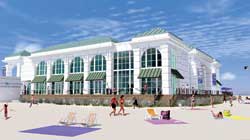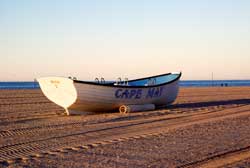Faculty and students develop plan to reshape Cape May tourism
| CONTACT: Brandon Lausch <blausch@temple.edu> 215-205-4115 |
| School of Tourism and Hospitality Management faculty and students are helping reshape Cape May, N.J., through an agreement that aims to revitalize tourism in the nation’s oldest seashore resort as it nears construction on the most expensive project in its history — an expanded convention center. Temple’s School of Tourism and Hospitality Management (STHM) is beginning its work this semester to devise a business and management plan for the $10.5 million facility, which is slated to open in 2011, and to create and implement long-term tourism and marketing efforts for Cape May. |
 Courtesy: Kimmel Bogrette Architecture and Site
An artist’s rendering of Cape May’s new eco-friendly convention hall, which will open next year.
|
| The partnership, passed unanimously by the City Council in August, started Sept. 1 and extends through March 2011.
“We really need to establish a firm database as to where we are, determine where we want to be in terms of a tourist niche and what we should plan to do to achieve our goal,” Mayor Ed Mahaney said. “And that’s what Temple is going to help us do.” Located between the Atlantic Ocean and Delaware estuary, Cape May is a National Historic Landmark with 600 Victorian houses and hotels. Throughout its history, Cape May has been able to expand its tourism season from the standard four- to six-month period into a 10.5-month economy, Mahaney said. But amid shifting market conditions and a slumping national economy, Mahaney said Cape May tourism, the city’s top industry, has been slipping back to about eight In the words of the mayor, a three-time Temple graduate, STHM is using “a grassroots-driven approach where the community drives the project through a series of questionnaires, interviews and public meetings.” Wes Roehl, STHM’s director of programs in tourism and hospitality management and coordinator of the Cape May partnership, said he is part of a five-member faculty team that will be researching and collecting visitor data, as well as the tourism goals of city officials, merchants and residents. STHM will be in charge of creating an organizational structure for the city’s new eco-friendly convention hall, as well as the training of its employees and venue scheduling to ensure the 1,150-seat facility is bringing in as much revenue as possible. In addition, the school is helping to reorganize Cape May’s Department of Civic Affairs and Recreation to expand and streamline tourism efforts. |
|
 Photo Courtesy: Cape May Magazine
Cape May is a National Historic Landmark located between the Atlantic Ocean and Delaware estuary.
Related Links
|
STHM students will participate in data collection, facilitate discussions during public forums and may contribute in the training of convention center employees, Roehl said. Roehl said interviews and meetings with officials and residents will continue in spring 2010. Final reports and presentations of suggested tourism master plans are expected to be finished in the fall of next year. After receiving feedback, Roehl said STHM hopes to make its final presentation in early 2011. But bolstering Cape May tourism won’t stop there. Roehl said that, by the end of the contract period, city officials should be equipped with “a sustainable system for understanding their visitors, responding to the changes in the marketplace and having a system in place where they can incorporate the wants and needs of their citizens.” |
|
STHM’s agreement with Cape May comes amid another Temple-related project in the city. The university’s Department of Landscape Architecture and Horticulture's Senior Studio course at Temple Ambler has begun a yearlong project to revitalize public green spaces in Cape May. Nearly 30 students will work on designs for several city parks and create plans for a new pedestrian and biking trail. “A project like this fits all of our missions — teaching, research and service missions,” Roehl said. “Obviously, the research, how it fits that mission, is clear. But it also fits our service mission, being able to give back to our various communities. And then it meets our teaching mission too because it gives us the opportunity to get students involved. It gives us an opportunity to have new stories to tell in class, new examples to give.” |
|